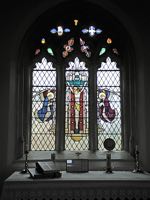
St Clare's Chapel, Livery Dole
Page aupdated 8th September 2017
 This small building at the
point of the Livery Dole triangle is a 'peculiar'
chapel, independent of the diocese. Livery Dole was a place of
execution for Exeter, so a Chantry Chapel was built between 1418 and
1439 that was used to pray for the souls of the executed. The gallows
or stake, depending on the method of execution, was in front of the
west end of the chapel, in the gardens
of the present almshouses. The earliest mention of the chapel was in a
document from 1439 stating "the
Chapel of St. Clarus
without the south gate, in the parish of Hevetre." When Henry VI
visited Bishop Lacy in Exeter during 1453, the monastic communities and
local clergy greeted him outside the chapel of St Clarus to escourt him
to the Cathedral.
This small building at the
point of the Livery Dole triangle is a 'peculiar'
chapel, independent of the diocese. Livery Dole was a place of
execution for Exeter, so a Chantry Chapel was built between 1418 and
1439 that was used to pray for the souls of the executed. The gallows
or stake, depending on the method of execution, was in front of the
west end of the chapel, in the gardens
of the present almshouses. The earliest mention of the chapel was in a
document from 1439 stating "the
Chapel of St. Clarus
without the south gate, in the parish of Hevetre." When Henry VI
visited Bishop Lacy in Exeter during 1453, the monastic communities and
local clergy greeted him outside the chapel of St Clarus to escourt him
to the Cathedral.
The almshouses next to the chapel were founded by Sir Robert Dennis in 1591 and completed by his brother, Sir Thomas Dennis in 1594, it is said, in penance for the execution of Thomas Benet by their ancestor, Sir Thomas Dennis, Sheriff of Devon in 1531. Dennis had a new chapel built, incorporating the old Chantry Chapel, for the spiritual needs of the occupiers of the almshouses. He also provided a chaplain to lead services and read prayers.
By 1823, the almshouses consisted of ten dwellings inhabited by ten poor men or women and a house for the chaplain. Income from an estate of 1,500 acres at Winterbourne Whitechurch, owned by Mr Compton a descendent of Sir Thomas Dennis, paid for the upkeep of the almshouses and the chaplain. Lord Rolle of Bicton, another descendent of Sir Thomas paid for the repairs to the chapel in 1851, and also appointed candidates when a vacancy arose, and appointed the chaplain.
The chapel is constructed from red Heavitree stone, that was extracted from, a quarry at appropriately, Quarry Lane. The stone is what is known as a breccia conglomerate from the Permian era, laid down by flood waters in a semi arid climate. Many churches in Exeter are constructed from Heavitree stone, which accounts for their poor condition, as the stone readily crumbles through weathering. St Clare's is no exception, and with the addition of heavy traffic on each side, the small building has to have constant maintenance. The interior walls are whitewashed, giving a very clean and simple look, with few memorials.
When Heavitree's St Michael's Church was closed for restoration between 1844 and 1846, St Clare's was licensed for marriages. Between 31 July 1844 and 26 July 1846, forty-five marriages were performed within its walls.
The bombing of the Second War destroyed the windows of the chapel, and an oak plaque explains their repair:
The windows in this chapel were destroyed by enemy action in May 1942 - the east window was erected in 1946 & the side windows were replaced in 1947 by the 21st Baron Clinton PC G CVO with fifteenth century glass brought from a tower at Bicton.
The chapel is still used by the occupants of the almshouses and some locals, who attend a service every Thursday. The 'peculiar' status requires that services are Anglican in nature.
Sources: Concise Account of the City of Exeter by Shirley Woolmer, Flying Post, Exeter Churches by Edith Cresswell, Transactions of the Exeter Diocesan Architectural Society 1853, Devon and Cornwall Notes and Queries 1907 and a guided tour by David Morrish.
│ Top of Page │



